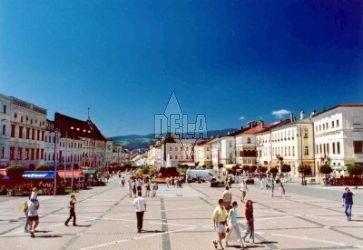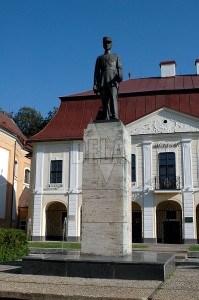


|
Tourist destinations | Towns and villages | Maps | Map | Hikes to the surroundings Accommodation and Services |

 The Horehronie region which was a part of the district of the city Zvolen in past, can be delimited by the districts of
Banská Bystrica and
Brezno. It is situated in the central part of Slovakia, starting at the spring of the river Hron and ending in Hronsek, where the district of
Banská Bystrica reaches its end. The river Hron is the second longest river in Slovakia (298 km), flowing into the Danube river in Štúrovo. Around its upper stream it is surrounded by
Nízke Tatry (Low Tatras) in the north, by Veporské vrchy (Veporské Hills) in the south, around the city of
Brezno it is surrounded again by
Nízke Tatry (Low Tatras) and Starohorské vrchy (Starohorské Hills) in the north, Kremnické vrchy (Kremnické Hills) in the west and by Zvolenská kotlina (Zvolenská Basin). Zvolenská Basin is surrounded by Kremnické vrchy (Kremnické Hills) and Starohorské vrchy (Starohorské Hills) in the south-east, by
Veľká Fatra (Great Fatra) and by
Nízke Tatry (Low Tatras) in the north and west and by Veporské vrchy (Veporské Hills) in the south. The local population still keeps their traditions in their everyday’s life (in the way they speak, dress, sing and dance).
The Horehronie region which was a part of the district of the city Zvolen in past, can be delimited by the districts of
Banská Bystrica and
Brezno. It is situated in the central part of Slovakia, starting at the spring of the river Hron and ending in Hronsek, where the district of
Banská Bystrica reaches its end. The river Hron is the second longest river in Slovakia (298 km), flowing into the Danube river in Štúrovo. Around its upper stream it is surrounded by
Nízke Tatry (Low Tatras) in the north, by Veporské vrchy (Veporské Hills) in the south, around the city of
Brezno it is surrounded again by
Nízke Tatry (Low Tatras) and Starohorské vrchy (Starohorské Hills) in the north, Kremnické vrchy (Kremnické Hills) in the west and by Zvolenská kotlina (Zvolenská Basin). Zvolenská Basin is surrounded by Kremnické vrchy (Kremnické Hills) and Starohorské vrchy (Starohorské Hills) in the south-east, by
Veľká Fatra (Great Fatra) and by
Nízke Tatry (Low Tatras) in the north and west and by Veporské vrchy (Veporské Hills) in the south. The local population still keeps their traditions in their everyday’s life (in the way they speak, dress, sing and dance).
 Another important centre is the city of
Brezno (23 thousand people). The first written reference about the city comes from the year 1265. In 1655 it became a royal city. The city centre has a squared shape where the following monuments are the most dominant: a city tower (belfry), church from the year 1785 and originally a classicistic town-hall from the year 1790 (nowadays a museum of the Horehronie region with the expositions of traditional dresses, embroideries and products made of wood). A literary - musical competition is organized here annually in May.
Another important centre is the city of
Brezno (23 thousand people). The first written reference about the city comes from the year 1265. In 1655 it became a royal city. The city centre has a squared shape where the following monuments are the most dominant: a city tower (belfry), church from the year 1785 and originally a classicistic town-hall from the year 1790 (nowadays a museum of the Horehronie region with the expositions of traditional dresses, embroideries and products made of wood). A literary - musical competition is organized here annually in May.










|
I cordially invite you to visit this beautiful part of Slovakia. Welcome Rudolf Kukura |
|